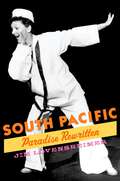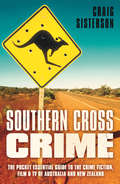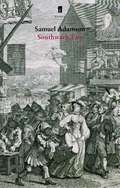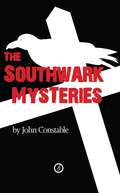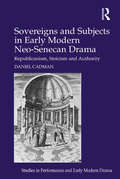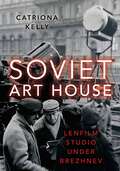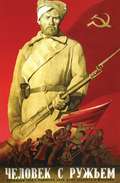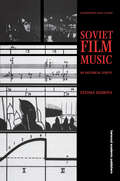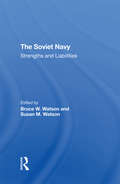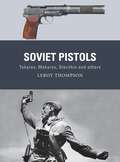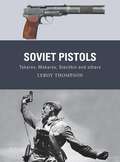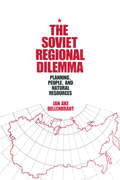- Table View
- List View
South Pacific: Paradise Rewritten (Broadway Legacies)
by Jim LovensheimerRodgers and Hammerstein's Tony and Pulitzer Prize-winning musical "South Pacific" has remained a mainstay of the American musical theater since it opened in 1949, and its powerful message about racial intolerance continues to resonate with twenty-first century audiences. Drawing on extensive research in the Rodgers and the Hammerstein papers, including Hammerstein's personal notes on James A. Michener's Tales of the South Pacific, Jim Lovensheimer offers a fascinating reading of "South Pacific" that explores the show's complex messages and demonstrates how the presentation of those messages changed throughout the creative process. Indeed, the author shows how Rodgers and especially Hammerstein continually refined and softened the theme of racial intolerance until it was more acceptable to mainstream Broadway audiences. Likewise, Lovensheimer describes the treatment of gender and colonialism in the musical, tracing how it both reflected and challenged early Cold War Era American norms. The book also offers valuable background to the writing of "South Pacific," exploring the earlier careers of both Rodgers and Hammerstein, showing how they frequently explored serious social issues in their other works, and discussing their involvement in the political movements of their day, such as Hammerstein's founding membership in the Hollywood Anti-Nazi League. Finally, the book features many wonderful appendices, including two that compare the original draft and final form of the classic songs "I'm Gonna Wash That Man Right Out-a My Hair" and "I'm In Love With a Wonderful Guy." Thoroughly researched and compellingly written, this superb book offers a rich, intriguing portrait of a Broadway masterpiece and the era in which it was created.
South Pacific: Paradise Rewritten (Broadway Legacies)
by Jim LovensheimerRodgers and Hammerstein's Tony and Pulitzer Prize-winning musical "South Pacific" has remained a mainstay of the American musical theater since it opened in 1949, and its powerful message about racial intolerance continues to resonate with twenty-first century audiences. Drawing on extensive research in the Rodgers and the Hammerstein papers, including Hammerstein's personal notes on James A. Michener's Tales of the South Pacific, Jim Lovensheimer offers a fascinating reading of "South Pacific" that explores the show's complex messages and demonstrates how the presentation of those messages changed throughout the creative process. Indeed, the author shows how Rodgers and especially Hammerstein continually refined and softened the theme of racial intolerance until it was more acceptable to mainstream Broadway audiences. Likewise, Lovensheimer describes the treatment of gender and colonialism in the musical, tracing how it both reflected and challenged early Cold War Era American norms. The book also offers valuable background to the writing of "South Pacific," exploring the earlier careers of both Rodgers and Hammerstein, showing how they frequently explored serious social issues in their other works, and discussing their involvement in the political movements of their day, such as Hammerstein's founding membership in the Hollywood Anti-Nazi League. Finally, the book features many wonderful appendices, including two that compare the original draft and final form of the classic songs "I'm Gonna Wash That Man Right Out-a My Hair" and "I'm In Love With a Wonderful Guy." Thoroughly researched and compellingly written, this superb book offers a rich, intriguing portrait of a Broadway masterpiece and the era in which it was created.
Southern Cross Crime: The Pocket Essential Guide to the Crime Fiction, Film and TV of Australia and New Zealand
by Craig SistersonAustralian and New Zealand crime and thriller writing - collectively referred to as Southern Cross Crime - is booming globally, with antipodean authors regularly featuring on awards and bestseller lists, such as Eleanor Catton's Booker Prize winning The Luminaries and Jane Harper's big commercial hit, The Dry, winner of the CWA Gold Dagger Award.Hailing from two sparsely populated nations on the far edge of the former Empire - neighbours that are siblings in spirit, vastly different in landscape - Australian and New Zealand crime writers offer readers a blend of exotic and familiar, seasoned by distinctive senses of place, outlook, and humour, and roots that trace to the earliest days of our genre.Southern Cross Crime is the first comprehensive guide to modern crime writing from "Down Under". From coastal cities to the outback, leading critic Craig Sisterson showcases key titles from over 250 storytellers, plus screen dramas ranging from Mystery Road to Top of the Lake. Fascinating insights are added through in-depth interviews with some of the prime suspects who paved the way or instigated the global boom, including Michael Robotham, Paul Cleave, Emma Viskic, Paul Thomas, Candice Fox, and Garry Disher.
Southwark Fair
by Samuel AdamsonSimon is looking forward to lunch with Patrick Mulligan, the first man he slept with nearly twenty years previously, while playing Puck in a school production. It soon becomes apparent that Patrick is expecting to see not Simon, but the boy who played Lysander, and their lunch is cut short. When Simon is approached by Patrick's wife the situation becomes increasingly tortured and darkly comic.Southwark Fair premiered at the National Theatre, London, in February 2006.
The Southwark Mysteries
by John Constable“I was born a Goose of Southwark by the Grace of Mary Overie, Whose Bishop gives me licence to sin within The Liberty. In Bankside stews and taverns you can hear me honk right daintily, As I unlock the hidden door, unveil the Secret History.” The Liberty of the Clink dates back to 1107 when the Bishop of Winchester was granted a stretch of the Southwark Bankside, which lay outside the law of the City of London. Here, the Bishop controlled the brothels, or stews. The whores of The Liberty were known as Winchester Geese. The Vision Books of The Southwark Mysteries were first revealed by The Goose to John Crow, trickster-familiar of the poet and playwright John Constable, on 23rd November 1996. In these apocalyptic verses, John Crow encounters The Goose at Crossbones, the whores’ graveyard unearthed during work on the Jubilee Line Extension. She initiates him into a secret history spanning 2,000 years – a vision of the Spirit in the flesh, the Sacred in the profane, Eternity in time. This vision informs The Mystery Plays, a contemporary “Southwark Cycle” rooted in the medieval mysteries, retelling sacred stories in the earthy language and context of our own time and place. This epic drama was first performed in Shakespeare’s Globe and Southwark Cathedral on Easter Sunday, 23rd April 2000. A new production was presented in Southwark Cathedral in 2010. The third part of the work is a Glossolalia of local history and esoteric lore to be read in conjunction with the poems and plays." "Past and present, sacred and profane jostle and collide in a glorious tumult in this anarchic drama... it’s couched in verse that is muscular, ribald, and often dazzlingly rich... It’s sprawling and unashamedly ragged in execution, but it’s irrepressibly vital: a joyous, gutsy celebration of life, love, faith and forgiveness. " - Sam Marlowe, The Times
Sovereigns and Subjects in Early Modern Neo-Senecan Drama: Republicanism, Stoicism and Authority
by Daniel CadmanSovereigns and Subjects in Early Modern Neo-Senecan Drama examines the development of neo-Senecan drama, also known as ’closet drama’, during the years 1590-1613. It is the first book-length study since 1924 to consider these plays - the dramatic works of Mary Sidney, Samuel Daniel, Samuel Brandon, Fulke Greville, Sir William Alexander, and Elizabeth Cary, along with the Roman tragedies of Ben Jonson and Thomas Kyd - as a coherent group. Daniel Cadman suggests these works interrogate the relations between sovereigns and subjects during the early modern period by engaging with the humanist discourses of republicanism and stoicism. Cadman argues that the texts under study probe various aspects of this dynamic and illuminate the ways in which stoicism and republicanism provide essential frameworks for negotiating this relationship between the marginalized courtier and the absolute sovereign. He demonstrates how aristocrats and courtiers, such as Sidney, Greville, Alexander, and Cary, were able to use the neo-Senecan form to consider aspects of their limited political agency under an absolute monarch, while others, such as Brandon and Daniel, respond to similarly marginalized positions within both political and patronage networks. In analyzing how these plays illuminate various aspects of early modern political culture, this book addresses several gaps in the scholarship of early modern drama and explores new contexts in relation to more familiar writers, as well as extending the critical debate to include hitherto neglected authors.
Sovereigns and Subjects in Early Modern Neo-Senecan Drama: Republicanism, Stoicism and Authority (Studies In Performance And Early Modern Drama Ser.)
by Daniel CadmanSovereigns and Subjects in Early Modern Neo-Senecan Drama examines the development of neo-Senecan drama, also known as ’closet drama’, during the years 1590-1613. It is the first book-length study since 1924 to consider these plays - the dramatic works of Mary Sidney, Samuel Daniel, Samuel Brandon, Fulke Greville, Sir William Alexander, and Elizabeth Cary, along with the Roman tragedies of Ben Jonson and Thomas Kyd - as a coherent group. Daniel Cadman suggests these works interrogate the relations between sovereigns and subjects during the early modern period by engaging with the humanist discourses of republicanism and stoicism. Cadman argues that the texts under study probe various aspects of this dynamic and illuminate the ways in which stoicism and republicanism provide essential frameworks for negotiating this relationship between the marginalized courtier and the absolute sovereign. He demonstrates how aristocrats and courtiers, such as Sidney, Greville, Alexander, and Cary, were able to use the neo-Senecan form to consider aspects of their limited political agency under an absolute monarch, while others, such as Brandon and Daniel, respond to similarly marginalized positions within both political and patronage networks. In analyzing how these plays illuminate various aspects of early modern political culture, this book addresses several gaps in the scholarship of early modern drama and explores new contexts in relation to more familiar writers, as well as extending the critical debate to include hitherto neglected authors.
Soviet Architectural Avant-Gardes: Architecture and Stalin’s Revolution from Above, 1928-1938
by Danilo Udovicki-SelbConventional readings of the history of Soviet art and architecture show modernist utopian aspirations as all but prohibited by 1932 under Stalin's totalitarianism. Soviet Architectural Avant-Gardes challenges that view. Radically redefining the historiography of the period, it reveals how the relationship between the Party and practicing architects was much more complex and contradictory than previously believed, and shows, in contrast to the conventional scholarly narrative, how the architectural avant-garde was able to persist at a time when it is widely considered to have been driven underground.In doing so, this book provides an essential perspective on how to analyse, evaluate, and “re-imagine” the history of modernist expression in its cultural context. It offers a new understanding of ways in which 20th century social revolutions and their totalitarian sequels inflected the discourse of both modernity and modernism. The book relies on close analyses of archival documents and architectural works. Many of the documents have been rarely – if ever – discussed in English before, while the architectural projects include iconic works such as the Palace of Soviets and the Soviet Pavilion at the Paris 1937 World Exposition, as well as remarkable works that until now have been neglected by architectural historians inside and outside Russia. In a fascinating final chapter, it also reveals for the first time the details of Frank Lloyd Wright's triumphant welcome at the First Congress of Soviet Architects in Moscow in 1937, at the height of Stalin's Terror.
Soviet Architectural Avant-Gardes: Architecture and Stalin’s Revolution from Above, 1928-1938
by Danilo Udovicki-SelbConventional readings of the history of Soviet art and architecture show modernist utopian aspirations as all but prohibited by 1932 under Stalin's totalitarianism. Soviet Architectural Avant-Gardes challenges that view. Radically redefining the historiography of the period, it reveals how the relationship between the Party and practicing architects was much more complex and contradictory than previously believed, and shows, in contrast to the conventional scholarly narrative, how the architectural avant-garde was able to persist at a time when it is widely considered to have been driven underground.In doing so, this book provides an essential perspective on how to analyse, evaluate, and “re-imagine” the history of modernist expression in its cultural context. It offers a new understanding of ways in which 20th century social revolutions and their totalitarian sequels inflected the discourse of both modernity and modernism. The book relies on close analyses of archival documents and architectural works. Many of the documents have been rarely – if ever – discussed in English before, while the architectural projects include iconic works such as the Palace of Soviets and the Soviet Pavilion at the Paris 1937 World Exposition, as well as remarkable works that until now have been neglected by architectural historians inside and outside Russia. In a fascinating final chapter, it also reveals for the first time the details of Frank Lloyd Wright's triumphant welcome at the First Congress of Soviet Architects in Moscow in 1937, at the height of Stalin's Terror.
Soviet Art House: Lenfilm Studio under Brezhnev
by Catriona KellyIts unique ability to sway the masses has led many observers to consider cinema the artform with the greatest political force. The images it produces can bolster leaders or contribute to their undoing. Soviet filmmakers often had to face great obstacles as they struggled to make art in an authoritarian society that put them not only under ideological pressure but also imposed rigid economic constraints on the industry. But while the Brezhnev era of Soviet filmmaking is often depicted as a period of great repression, Soviet Art House reveals that the films made at the prestigious Lenfilm studio in this period were far more imaginative than is usually suspected. In this pioneering study of a Soviet film studio, author Catriona Kelly delves into previously unpublished archival documents and interviews, memoirs, and the films themselves to illuminate the ideological, economic, and aesthetic dimensions of filmmaking in the Brezhnev era. She argues that especially the young filmmakers who joined the studio after its restructuring in 1961 revitalized its output and helped establish Leningrad as a leading center of oppositional art. This unique insight into Soviet film production shows not only the inner workings of Soviet institutions before the system collapsed but also traces how filmmakers tirelessly dodged and negotiated contradictory demands to create sophisticated and highly original movies.
Soviet Cinema: Politics and Persuasion Under Stalin (KINO - The Russian and Soviet Cinema)
by Jamie MillerWhen the Bolsheviks seized power in the Soviet Union during 1917, they were suffering from a substantial political legitimacy deficit. Uneasy political foundations meant that they were always on the defensive and cinema became a key part of the strategy to protect the existence of the USSR. This welcome book shows how one of film's central functions was as an important means of convincing the masses that the regime was legitimate and a bearer of historical truth.Based on extensive research in archives and primary sources, the book examines the interaction between politics and the Soviet cinema industry during the period between Stalin's rise to power and the beginning of the Great Patriotic War. This was the era when the Bolsheviks were trying to develop a 'cinema for the millions', which sought to engage Soviet citizens politically by carefully blending entertainment with the communist message.Jamie Miller investigates how political and administrative decision-making, censorship, thematic planning and purges were shaped by the Bolsheviks' defensive outlook, which in turn had a largely negative impact on the production process. He examines the role of film unions and societies, compares the development of two different studios and looks at the education system for cinema personnel. He also analyses key films of the period, including the classic musical Circus, the class enemy drama The Party Card and the political epic The Great Citizen.
Soviet Critical Design: Senezh Studio and the Communist Surround (Cultural Histories of Design)
by Tom CubbinSoviet Critical Design is the first monograph to explore the socialist design practice of 'artistic projecteering', which was developed by the USSR's Senezh Experimental Studio in the 1960s.Tom Cubbin first examines the studio as a site for the development of the design discipline in the optimistic environment of the Soviet Thaw of the 1960s. He then explores how designers adapted to new realities of the Soviet Union of the 1970s and 80s. Over two decades, designers at the studio worked on critical projects that highlighted how the Soviet state's treatment of citizens, urban heritage and the environment was manifest in daily life.Drawing on previously unpublished visual material from private archives and also extensive interviews, this book presents a new history of the late socialist period in the USSR, which gives insight into the creative strategies of designers who engaged their practice as a contribution to broader discussions on alternative models for socialist existence. Overall, it argues that artistic projecteering must be read as a utopian activity which privileged the political and ideological over the functional.
Soviet Critical Design: Senezh Studio and the Communist Surround (Cultural Histories of Design)
by Tom CubbinSoviet Critical Design is the first monograph to explore the socialist design practice of 'artistic projecteering', which was developed by the USSR's Senezh Experimental Studio in the 1960s.Tom Cubbin first examines the studio as a site for the development of the design discipline in the optimistic environment of the Soviet Thaw of the 1960s. He then explores how designers adapted to new realities of the Soviet Union of the 1970s and 80s. Over two decades, designers at the studio worked on critical projects that highlighted how the Soviet state's treatment of citizens, urban heritage and the environment was manifest in daily life.Drawing on previously unpublished visual material from private archives and also extensive interviews, this book presents a new history of the late socialist period in the USSR, which gives insight into the creative strategies of designers who engaged their practice as a contribution to broader discussions on alternative models for socialist existence. Overall, it argues that artistic projecteering must be read as a utopian activity which privileged the political and ideological over the functional.
Soviet Factography: Reality without Realism
by Devin ForeA study of Soviet factography, an avant-garde movement that employed photography, film, journalism, and mass media technologies. This is the first major English-language study of factography, an avant-garde movement of 1920s modernism. Devin Fore charts this style through the work of its key figures, illuminating factography’s position in the material culture of the early Soviet period and situating it as a precursor to the genre of documentary that arose in the 1930s. Factographers employed photography and film practices in their campaign to inscribe facts and to chronicle modernization as it transformed human experience and society. Fore considers factography in light of the period’s explosion of new media technologies—including radio broadcasting, sound in film, and photo-media innovations—that allowed the press to transform culture on a massive scale. This theoretically driven study uses material from Moscow archives and little-known sources to highlight factography as distinct from documentary and Socialist Realism and to establish it as one of the major twentieth-century avant-garde forms. Fore covers works of photography, film, literature, and journalism together in his considerations of Soviet culture, the interwar avant-gardes, aesthetics, and the theory of documentary.
Soviet Factography: Reality without Realism
by Devin ForeA study of Soviet factography, an avant-garde movement that employed photography, film, journalism, and mass media technologies. This is the first major English-language study of factography, an avant-garde movement of 1920s modernism. Devin Fore charts this style through the work of its key figures, illuminating factography’s position in the material culture of the early Soviet period and situating it as a precursor to the genre of documentary that arose in the 1930s. Factographers employed photography and film practices in their campaign to inscribe facts and to chronicle modernization as it transformed human experience and society. Fore considers factography in light of the period’s explosion of new media technologies—including radio broadcasting, sound in film, and photo-media innovations—that allowed the press to transform culture on a massive scale. This theoretically driven study uses material from Moscow archives and little-known sources to highlight factography as distinct from documentary and Socialist Realism and to establish it as one of the major twentieth-century avant-garde forms. Fore covers works of photography, film, literature, and journalism together in his considerations of Soviet culture, the interwar avant-gardes, aesthetics, and the theory of documentary.
Soviet Film Music (Contemporary Music Studies)
by Tatiana EgorovaFirst Published in 1998. Routledge is an imprint of Taylor & Francis, an informa company.
Soviet Film Music (Contemporary Music Studies)
by Tatiana EgorovaFirst Published in 1998. Routledge is an imprint of Taylor & Francis, an informa company.
The Soviet Navy: Strengths And Liabilities
by Bruce W. Watson Susan M Watson Calland Carnes Brian LarsonSince Admiral Sergei G. Gorshkov was appointed to the office of commander in chief of the Soviet Navy in 1956, the Soviet Union has made a massive investment in naval construction, training, and operations. As a result, the Soviet Navy has grown from a coastal defense force to one of the world's two strongest navies. This book offers a detailed assessment of every major aspect of the Soviet Navy, from fleet structure and training facilities to command and control procedures and warfare and intelligence collection capabilities.
The Soviet Navy: Strengths And Liabilities
by Bruce W. Watson Susan M Watson Calland Carnes Brian LarsonSince Admiral Sergei G. Gorshkov was appointed to the office of commander in chief of the Soviet Navy in 1956, the Soviet Union has made a massive investment in naval construction, training, and operations. As a result, the Soviet Navy has grown from a coastal defense force to one of the world's two strongest navies. This book offers a detailed assessment of every major aspect of the Soviet Navy, from fleet structure and training facilities to command and control procedures and warfare and intelligence collection capabilities.
Soviet Pistols: Tokarev, Makarov, Stechkin and others (Weapon)
by Leroy ThompsonThis is the absorbing story of the development, combat use and legacy of the influential sidearms used by the armed forces of the Soviet Union.Featuring archive and present-day photography and specially commissioned artwork, this is the story of the pistols that armed the forces of the Soviet Union and its allies during and after World War II. In 1930 the TT, a single-action semi-automatic pistol developed by Fedor Vasilyevich Tokarev and firing 7.62×25mm ammunition, began to supplement the venerable Nagant M1895 revolver in Soviet military service. From 1933 the TT-33, a simplified version, was also issued; all three would equip Soviet and proxy forces throughout and after World War II, seeing action across the globe.In 1951 a new pistol designed by Nikolay Fyodorovich Makarov entered Soviet service; it became the primary Soviet military and police sidearm during the Cold War era and continued in use into the 21st century. The 9×18mm Makarov round was used in various weapons used by Soviet allies, notably the Czech vz 82, the Hungarian FÉG PA63 and the Polish P64 and P83.The PM was quickly joined by the Stechkin machine pistol. Other specialized versions of the Makarov were developed, including the PB suppressed version and the 5.45×18mm PSM, a more compact version. Initially developed in 1990, the improved PMM version of the Makarov was intended primarily to increase the stopping power of the 9×18mm round by chambering a higher-pressure load.In this study, noted weaponry expert Leroy Thompson tells the story of the Tokarev, Makarov, Stechkin and other handguns in service with Soviet and other forces around the world, exploring the development, combat use and legacy of these formidable firearms.
Soviet Pistols: Tokarev, Makarov, Stechkin and others (Weapon)
by Leroy ThompsonThis is the absorbing story of the development, combat use and legacy of the influential sidearms used by the armed forces of the Soviet Union.Featuring archive and present-day photography and specially commissioned artwork, this is the story of the pistols that armed the forces of the Soviet Union and its allies during and after World War II. In 1930 the TT, a single-action semi-automatic pistol developed by Fedor Vasilyevich Tokarev and firing 7.62×25mm ammunition, began to supplement the venerable Nagant M1895 revolver in Soviet military service. From 1933 the TT-33, a simplified version, was also issued; all three would equip Soviet and proxy forces throughout and after World War II, seeing action across the globe.In 1951 a new pistol designed by Nikolay Fyodorovich Makarov entered Soviet service; it became the primary Soviet military and police sidearm during the Cold War era and continued in use into the 21st century. The 9×18mm Makarov round was used in various weapons used by Soviet allies, notably the Czech vz 82, the Hungarian FÉG PA63 and the Polish P64 and P83.The PM was quickly joined by the Stechkin machine pistol. Other specialized versions of the Makarov were developed, including the PB suppressed version and the 5.45×18mm PSM, a more compact version. Initially developed in 1990, the improved PMM version of the Makarov was intended primarily to increase the stopping power of the 9×18mm round by chambering a higher-pressure load.In this study, noted weaponry expert Leroy Thompson tells the story of the Tokarev, Makarov, Stechkin and other handguns in service with Soviet and other forces around the world, exploring the development, combat use and legacy of these formidable firearms.
The Soviet Regional Dilemma
by Jan Ake DellenbrantIncorporating an oral history approach, this history of radio covers the impact of the arrival of television, the rise of transistor radios, the popularity of rock n' roll, FM stereo stations, underground radio of the sixties, talk radio, public radio, and how technology will affect its future.
The Soviet Regional Dilemma
by Jan Ake DellenbrantIncorporating an oral history approach, this history of radio covers the impact of the arrival of television, the rise of transistor radios, the popularity of rock n' roll, FM stereo stations, underground radio of the sixties, talk radio, public radio, and how technology will affect its future.
Soviet Socialist Realism and Art in the Asia-Pacific (Routledge Research in Art and Politics)
by Alison CarrollThis study evaluates how the ideology of Socialist Realism, developed by the Soviets in policies and the practices of art, has been influential in the Asia-Pacific region from 1917 until today.Focusing primarily on Russia, then China, Vietnam, Korea, Singapore, Indonesia, the Philippines and Australia, this book demonstrates how each society adopted and adapted the Soviet example to make some of the most important imagery of recent history. Included is an examination of how the practice of Western art history, the nature of art history in Asia and the forces of the Cold War have led to this influence being inadequately acknowledged across Asia and more widely.The book will be relevant to those interested in art history, Asian studies, political history and cultural history.
Soviet Socialist Realism and Art in the Asia-Pacific (Routledge Research in Art and Politics)
by Alison CarrollThis study evaluates how the ideology of Socialist Realism, developed by the Soviets in policies and the practices of art, has been influential in the Asia-Pacific region from 1917 until today.Focusing primarily on Russia, then China, Vietnam, Korea, Singapore, Indonesia, the Philippines and Australia, this book demonstrates how each society adopted and adapted the Soviet example to make some of the most important imagery of recent history. Included is an examination of how the practice of Western art history, the nature of art history in Asia and the forces of the Cold War have led to this influence being inadequately acknowledged across Asia and more widely.The book will be relevant to those interested in art history, Asian studies, political history and cultural history.
